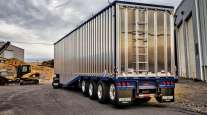April Trailer Orders Rise 20.2% as Fleets Begin to Add Capacity
This story appears in the June 2 print edition of Transport Topics.
New trailer orders rose 20.2% in April from a year earlier, ACT Research reported, as more fleets begin to add equipment, rather than just replace existing units.
U.S. trailer manufacturers booked 26,389 net orders in April, compared with 21,954 in the same month a year ago, ACT said.
ACT analyst Frank Maly said tightening freight capacity is “finally getting [carriers] to realize that there really is enough demand out there for them to put more equipment on the road.”
Lost productivity from last year’s hours-of-service changes also is adding pressure on carriers to expand their trailer fleets, he said.
While replacement demand always represents the majority of purchases, capacity expansion is beginning to represent a larger slice, according to fleets surveyed by ACT.
Although April’s order total outpaced year-ago levels, it declined 10.2% from the 29,373 added in March. Maly attributed the downturn to typical seasonal patterns.
“In April, you expect things to start to level out as the industry’s order season closes,” he said. “That’s not surprising at all.”
Through four months, trailer orders have totaled 111,317 in 2014, up 43.8% from 77,395 in the same timeframe last year.
April’s year-over-year growth rate was down from the spikes seen earlier this year, including jumps of 71.6% in March and 65.6% in February.
Trailer makers said they continue to boost production to meet customer demand, but they offered mixed views on just how much fleet expansion is taking place.
“Great Dane saw a very strong start of the year as our backlogs reflect the influx of orders,” said Chris Hammond, vice president of dealer and international sales at Great Dane Trailers. “We have most lines into the fourth quarter with a few filled through the end of the year.”
He agreed that tightening capacity is playing a role in the trailer market.
“Tight capacity in the industry with a growing — albeit small growth — economy has made new purchases key to the success of our customers’ growth,” Hammond said.
He said the company expects build rates will continue to grow at a “modest” pace.
Utility Trailer Manufacturing Co. continues to see a mix of both replacement and fleet-expansion orders, said Larry Roland, the company’s marketing director.
Utility’s order intake peaked in March but remained “strong” in April, he said.
The company’s backlog reached an all-time high at the end of March, driven by “the rush to catch up on delayed replacement orders due to the recession,” as well as increased freight demand, Roland said. Production rates are increasing steadily in most product lines, he added.
Glenn Harney, chief sales officer at Hyundai Translead, said April was the company’s best month so far this year for incoming orders, and its backlog is at a record high.
Most of the new orders are still replacement, he said, “but it looks like some growth is being added.”
Harney said the company’s trailer production rate will increase slightly in May and stay at that level at least through October. Hyundai Translead also plans to double its chassis production from June through August, he added.
“Based on our quote activity there is a good chance both trailers and chassis will remain at these elevated levels through year end,” Harney said.
David Giesen, vice president of sales and marketing at Stoughton Trailers, said most of the order activity seems to be replacement, with only “very little” growth.
He said carriers are looking to bring down the average age of their trailer fleets.
“I think that’s what’s driving it — getting some new equipment out there so you have a lower age of fleet and lower maintenance costs,” Giesen said.
He also said large fleets are the “driving force” behind the strong order intake.
Stoughton currently has one of the strongest backlogs in company history and is now filling its order board into the middle of the fourth quarter, Giesen added.
“We’re going to be adding capacity through the summer,” he said. “We’re hiring people now to help build what we’ve booked.”
ACT’s Maly said the majority of the strength in the trailer market is being fueled by the dry van and reefer segments, while the rest of the market is “just holding its own.”
Earlier in year, the growth was driven primarily by the large fleets, but he said small and medium-size fleets are also moving forward with purchasing plans now.
“They’ve got to keep up with the Joneses,” Maly said. “They have to keep up their fleets to be able to compete effectively with the large guys.”
Industry backlogs rose to almost 122,000 units at the end of April, representing about 5.5 to 6 months of production, Maly said.
“You’re looking at an order board right now that will push the industry through the spring and summer and into the fall,” Maly said. “There’s definitely a good, solid foundation as we move into the production season.”
Although new orders have risen sharply this year, they haven’t yet translated to major growth in new registrations.
New commercial trailer registrations increased just 2.3% year-over-year in the first quarter, to 56,100 units, according to the latest Polk commercial vehicle report from IHS Automotive.




